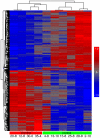Vaginal microbiome and epithelial gene array in post-menopausal women with moderate to severe dryness
- PMID: 22073175
- PMCID: PMC3206802
- DOI: 10.1371/journal.pone.0026602
Vaginal microbiome and epithelial gene array in post-menopausal women with moderate to severe dryness
Abstract
After menopause, many women experience vaginal dryness and atrophy of tissue, often attributed to the loss of estrogen. An understudied aspect of vaginal health in women who experience dryness due to atrophy is the role of the resident microbes. It is known that the microbiota has an important role in healthy vaginal homeostasis, including maintaining the pH balance and excluding pathogens. The objectives of this study were twofold: first to identify the microbiome of post-menopausal women with and without vaginal dryness and symptoms of atrophy; and secondly to examine any differences in epithelial gene expression associated with atrophy. The vaginal microbiome of 32 post-menopausal women was profiled using Illumina sequencing of the V6 region of the 16S rRNA gene. Sixteen subjects were selected for follow-up sampling every two weeks for 10 weeks. In addition, 10 epithelial RNA samples (6 healthy and 4 experiencing vaginal dryness) were acquired for gene expression analysis by Affymetrix Human Gene array. The microbiota abundance profiles were relatively stable over 10 weeks compared to previously published data on premenopausal women. There was an inverse correlation between Lactobacillus ratio and dryness and an increased bacterial diversity in women experiencing moderate to severe vaginal dryness. In healthy participants, Lactobacillus iners and L. crispatus were generally the most abundant, countering the long-held view that lactobacilli are absent or depleted in menopause. Vaginal dryness and atrophy were associated with down-regulation of human genes involved in maintenance of epithelial structure and barrier function, while those associated with inflammation were up-regulated consistent with the adverse clinical presentation.
Conflict of interest statement
Figures



References
-
- Santoro N, Komi J. Prevalence and impact of vaginal symptoms among postmenopausal women. J Sex Med. 2009;6:2133–2142. - PubMed
-
- Simon JA, Reape KZ. Understanding the menopausal experiences of professional women. Menopause. 2009;16:73–76. - PubMed
-
- Sturdee DW, Panay N. Recommendations for the management of postmenopausal vaginal atrophy. Climacteric. 2010;13:509–522. - PubMed
-
- Raz R, Stamm WE. A controlled trial of intravaginal estriol in postmenopausal women with recurrent urinary tract infections. N Engl J Med. 1993;329:753–756. - PubMed
Publication types
MeSH terms
Substances
Associated data
- Actions
- Actions
- Actions
- Actions
- Actions
- Actions
- Actions
- Actions
- Actions
- Actions
- Actions
- Actions
- Actions
- Actions
- Actions
- Actions
- Actions
- Actions
- Actions
- Actions
- Actions
- Actions
- Actions
- Actions
- Actions
- Actions
- Actions
- Actions
- Actions
- Actions
- Actions
- Actions
- Actions
- Actions
- Actions
- Actions
- Actions
- Actions
- Actions
- Actions
- Actions
- Actions
- Actions
- Actions
- Actions
- Actions
- Actions
- Actions
- Actions
- Actions
- Actions
- Actions
- Actions
- Actions
- Actions
- Actions
- Actions
- Actions
- Actions
- Actions
- Actions
- Actions
- Actions
- Actions
- Actions
- Actions
- Actions
- Actions
- Actions
- Actions
- Actions
- Actions
- Actions
- Actions
- Actions
- Actions
- Actions
- Actions
- Actions
- Actions
- Actions
- Actions
- Actions
- Actions
- Actions
- Actions
- Actions
- Actions
- Actions
- Actions
- Actions
- Actions
- Actions
- Actions
- Actions
- Actions
- Actions
- Actions
- Actions
- Actions
- Actions
- Actions
- Actions
- Actions
- Actions
- Actions
- Actions
- Actions
- Actions
- Actions
- Actions
- Actions
- Actions
- Actions
- Actions
- Actions
- Actions
- Actions
- Actions
- Actions
LinkOut - more resources
Full Text Sources
Other Literature Sources
Medical
Molecular Biology Databases

